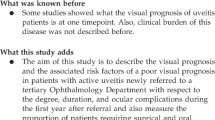Abstract
Background
To analyze the pattern and causes of visual loss in patients with Behçet’s uveitis and to report on the short-term outcome at 6 months and at last follow-up visit. Also, to analyze the pattern of visual acuity changes in eyes with and without macular involvement at the specified time points.
Methods
This is a retrospective cohort study of a single-center in an academic practice. Fifty-three patients with Behçet’s uveitis evaluated between 2004 and 2014 were included. Data on patients diagnosed with Behçet’s uveitis were entered retrospectively into a database and analyzed.
Results
Included were 93 eyes with Behçet’s uveitis involving the posterior segment. Frequencies of ≤20/50 and of ≤20/200 VA at presentation were 23.7% and 37.6%, respectively. Retinitis, macular inflammatory infiltrate, and dense vitritis were significantly associated with worse vision. Eyes with macular atrophy and macular inflammatory infiltrate sustained the worst logMAR VA at presentation (1.87 and 1.73, respectively) compared to eyes with cystoid macular edema and epiretinal membrane (0.76 and 0.63, respectively). Eyes with no macular involvement had the best VA at presentation. Mean difference in logMAR VA between presentation and the specified time points was greatest for eyes with macular inflammatory infiltrate.
Conclusions
Behçet’s disease affected mostly young males with a male-to-female ratio of 4.8:1. Panuveitis and posterior uveitis were the predominant forms and they were intrinsically associated with sight-threatening potential and breadth of ocular complications for which aggressive immunosuppressive therapy was essential.






Similar content being viewed by others
References
Tugal-Tutkun I (2009) Behçet’s Uveitis. Middle East Afr J Ophthalmol 16:219–224
Evereklioglu C (2005) Review. Current concepts in the etiology and treatment of Behçet disease. Surv Ophthalmol 50(4):297–350
International Study Group for Behçet’s Disease (1990) Evaluation of diagnostic (‘classification’) criteria in Behçet’s disease: toward internationally agreed criteria. Lancet 335:1078–1080
Jabs DA, Nussenblatt RB, Rosenbaum JT et al (2005) Standardization of uveitis nomenclature for reporting clinical data. Results of the first international workshop. Am J Ophthalmol 140:509–516
Nussenblatt RB, Palestine AG, Chan CC, Roberge F (1985) Standardization of vitreal inflammatory activity in intermediate and posterior uveitis. Ophthalmology 92:467–471
Behcet’s Disease Research Committee of Japan (1974) Behcet’s disease guide to the diagnosis of Behcet’s disease (1972). Jpn J Ophthalmol 18:291–294
Tugal-Tutkun I, Onal S, Altan-Yaycioglu R, Huseyin Altunbas H, Urgancioglu M (2004) Uveitis in Behçet disease: an analysis of 880 patients. Am J Ophthalmol 138(3):373–380
Arevalo JF, Lasave AF, Al Jindan MY, KKESH Uveitis Survey Study Group; KKESH Uveitis Survey Study Group et al (2015) Uveitis in Behçet disease in a tertiary center over 25 years: the KKESH uveitis Survey study group. Am J Ophthalmol 159(1):177–184
Yoshida A, Kawashima H, Motoyama Y et al (2004) Comparison of patients with Behçet’s disease in the 1980s and 1990s. Ophthalmology 111:810–815
Dana MR, Merayo-Lloves J, Schaumberg DA, Foster CS (1997) Visual outcomes prognosticators in juvenile rheumatoid arthritis-associated uveitis. Ophthalmology 104(2):236–244
Hatemi G, Silman A, Bang D et al (2008) EULAR expert committee. EULAR recommendations for the management of Behçet disease. Ann Rheum Dis 67(12):1656–1662
Khairallah M, Attia S, Yahia SB et al (2009) Pattern of uveitis in Behçet’s disease in a referral center in Tunisia, North Africa. Int Ophthalmol 29(3):135–141
Kaçmaz RO, Kempen JH, Newcomb C, Systemic Immunosuppressive Therapy for Eye Diseases Cohort Study Group et al (2008) Ocular inflammation in Behçet disease: incidence of ocular complications and of loss of visual acuity. Am J Ophthalmol 146(6):828–836
Yang P, Fang W, Meng Q, Ren Y, Xing L, Kijlstra A (2008) Clinical features of Chinese patients with Behçet’s disease. Ophthalmology 115(2):312–318.e4
Kaburaki T, Namba K, Sonoda KH, Ocular Behçet Disease Research Group of Japan et al (2014) Behçet’s disease ocular attack score 24: evaluation of ocular disease activity before and after initiation of infliximab. Jpn J Ophthalmol 58(2):120–130
BenEzra D, Cohen E (1986) Treatment and visual prognosis in Behçet’s disease. Br J Ophthalmol 70:589–592
Cingu AK, Onal S, Urgancioglu M, Tugal-Tutkun I (2012) Comparison of presenting features and three-year disease course in Turkish patients with Behçet uveitis who presented in the early 1990s and the early 2000s. Ocul Immunol Inflamm 20:423–428
Taylor SR, Singh J, Menezo V, Wakefield D, McCluskey P, Lightman S (2011) Behçet disease: visual prognosis and factors influencing the development of visual loss. Am J Ophthalmol 152:1059–1066
Author information
Authors and Affiliations
Corresponding author
Ethics declarations
Funding
No funding was received for this research.
Conflict of interest
All authors certify that they have no affiliations with or involvement in any organization or entity with any financial interest (such as honoraria; educational grants; participation in speakers’ bureaus; membership, employment, consultancies, stock ownership, or other equity interest; and expert testimony or patent-licensing arrangements), or non-financial interest (such as personal or professional relationships, affiliations, knowledge or beliefs) in the subject matter or materials discussed in this manuscript.
Ethical approval
All procedures performed in studies involving human participants were in accordance with the ethical standards of the institutional and/or national research committee and with the 1964 Helsinki declaration and its later amendments or comparable ethical standards.
For this type of study (retrospective study) formal consent is not required.
Rights and permissions
About this article
Cite this article
Amer, R., Alsughayyar, W. & Almeida, D. Pattern and causes of visual loss in Behçet’s uveitis: short-term and long-term outcomes. Graefes Arch Clin Exp Ophthalmol 255, 1423–1432 (2017). https://doi.org/10.1007/s00417-017-3667-0
Received:
Revised:
Accepted:
Published:
Issue Date:
DOI: https://doi.org/10.1007/s00417-017-3667-0




